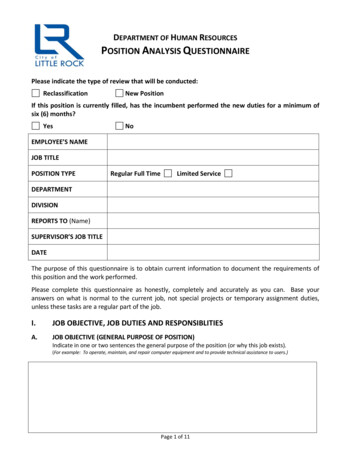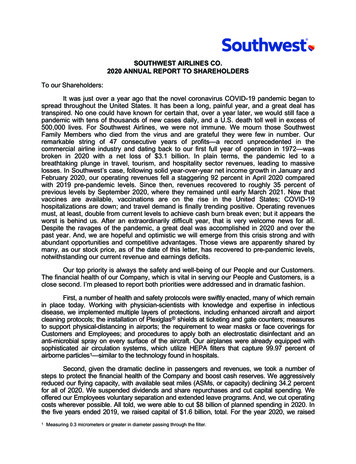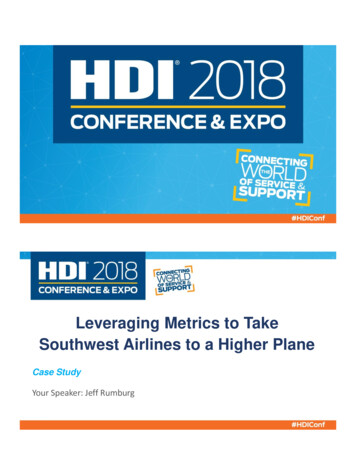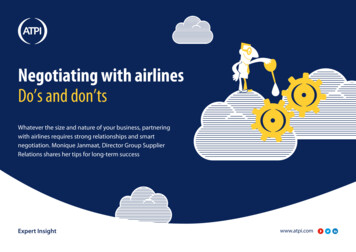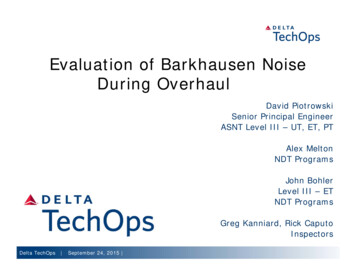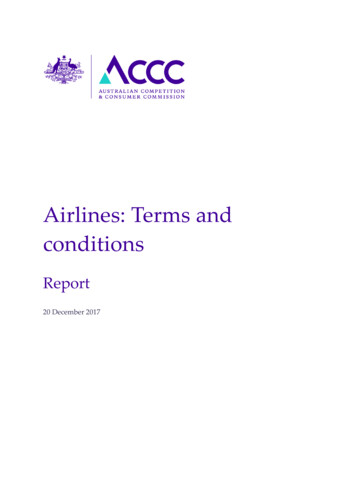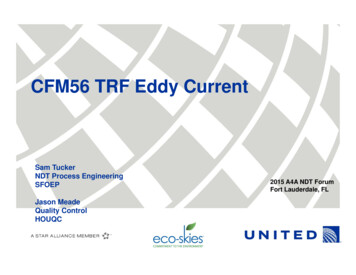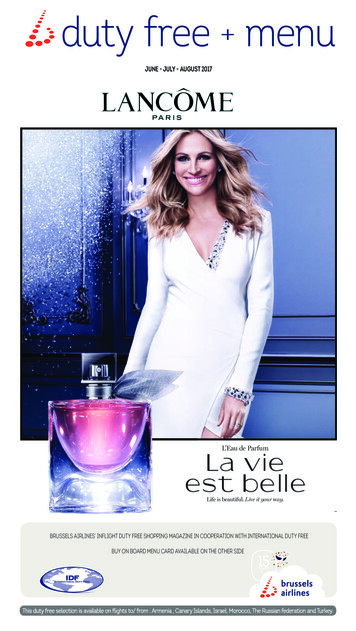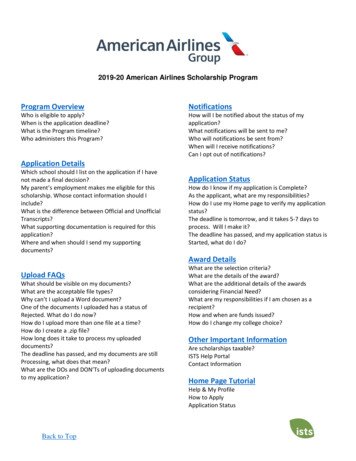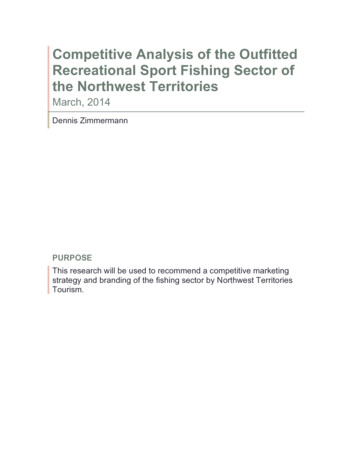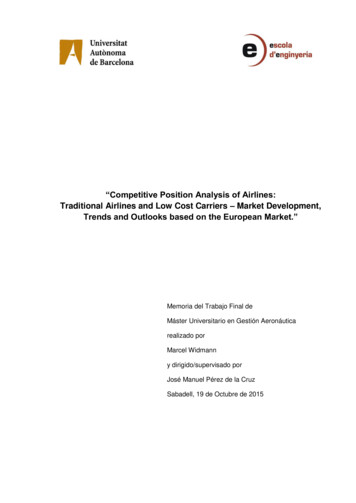
Transcription
“Competitive Position Analysis of Airlines:Traditional Airlines and Low Cost Carriers – Market Development,Trends and Outlooks based on the European Market.”Memoria del Trabajo Final deMáster Universitario en Gestión Aeronáuticarealizado porMarcel Widmanny dirigido/supervisado porJosé Manuel Pérez de la CruzSabadell, 19 de Octubre de 2015
Page: 1/118
Page: 2/118Table of Contents1Introduction . 62Aviation market and airlines . 82.132.1.1Full-Service carrier (scheduled airlines) . 82.1.2Charter airlines (non-scheduled airlines) . 102.1.3Regional airlines (scheduled airlines) . 112.2History and definition of low cost carriers (scheduled airlines) . 122.3Strategic alliances in the aviation market . 13Traditional airlines and low cost carriers – competitor analysis . 153.14Market share development (of airline types) . 153.1.1The development of the market share worldwide and in Europe . 153.1.2The development of the market share in Germany and Spain . 173.2The actual low cost carrier market in Europe . 223.3Medium-term outlook (up to 2020) – overall European aviation market . 253.4Cost and price calculation / comparison of prices . 263.4.1Cost calculation – differences between low cost carriers and traditional airlines . 263.4.2Potential cost savings for airlines . 283.4.3Flight price comparison between low cost carriers . 293.5Fleet of low cost carriers . 323.6Safety aspects. 34General competitor strategies . 364.1M. E. Porter’s theory . 364.1.1Differentiation strategy . 374.1.2Cost leadership strategy. 374.1.3Concentration strategies (focus strategies) . 384.25Definition of traditional airlines . 8Outpacing strategy – a dynamic model of Gilbert and Strebel . 384.2.1Definitions and backgrounds . 384.2.2Branch development . 394.2.3Strategic alternatives . 40The use of the competitor strategies in the practice . 42 Case studies / examples of airlines and expert interviews with airlines5.1Lufthansa – the traditional airline (including Germanwings, Eurowings) . 425.1.1Company profile and strategy . 42
Page: 3/1185.1.25.2Expert interview with Lufthansa . 47Vueling – a representative of the low cost carriers (an airline of the IAG Group) . 535.2.1Company profile and strategy . 535.2.2Expert interview with Vueling . 565.3Air Berlin (short additional example) . 59 Expert interviews with stakeholders - handling companies / suppliers5.4Swissport . 605.4.1Company profile . 605.4.2Expert interview with Swissport . 615.5Groundforce . 625.5.1Company Profile . 625.5.2Expert interview with Groundforce . 63 Surveys with stakeholders - flight passengers / customers5.6Background information of the surveys. 6665.7Results out of the surveys . 665.8Summary of the surveys. 80Conclusion. 846.1Trends and outlook . 846.2Own recommendations to the future development of the airline business in Europe . 856.3Closing words . 877Appendix . 898Bibliography / Sources . 113
Page: 4/118List of FiguresFigure 1: Star Alliance - facts and figures . 14Figure 2: Benefits of a strategic alliance . 14Figure 3: Low cost carriers – historical growth development 2000-2006 worldwide . 15Figure 4: Growth development various airline types 2000-2010 Europe. 16Figure 5: LCC – market share related to seat capacity 2001-2012 (worldwide and Europe) . 16Figure 6: Market share development of airline types 2002-2013 (Germany) . 18Figure 7: Shift of market share development of airline types 2003-2013 (Germany) . 18Figure 8: Number of int. passenger arrivals Spain via air transportation (2001-2013) . 20Figure 9: Number of int. passenger arrivals Spain via low cost carriers (2001-2013) . 20Figure 10: Number of int. passenger arrivals Spain via traditional airlines (2001-2013) . 21Figure 11: Overview low cost carriers Europe . 23Figure 12: LCC - overview take-offs, seats and flight routes Europe per airline (01/2015) . 24Figure 13: LCC - overview take-offs, seats and flight routes in Europe per country (01/2015) . 24Figure 14: Average annual growth of flights per state, 2020 vs. 2013 . 26Figure 15: Cost calculation - differences between low cost carriers and traditional airlines . 26Figure 16: Cost per available seat kilometre (ASK) - 2012 vs. 2005 . 27Figure 17: Flight prices of selected low cost carriers (average) . 30Figure 18: Flight prices selected low cost carriers based on booking time in advance (DLR 2012) 30Figure 19: Flight prices selected low cost carriers based on booking time in advance (DLR 2014) 31Figure 20: Examples ticket price management (DLR 2012 and airline reports) . 31Figure 21: Low cost carriers - overview fleet (based on ELFAA, Dec. 2014) . 32Figure 22: Low cost carriers - overview fleet (based on DLR Low Cost Monitor, 01/2015) . 33Figure 23: Strategic approach according to Porter . 36Figure 24: Visualisation of the outpacing strategy . 40Figure 25: Deutsche Lufthansa AG - overview current organisation (organisational chart) . 43Figure 26: Lufthansa – main pillars of the global strategy . 44Figure 27: Lufthansa - "7to1 – initiative, the seven areas of action”. 44Figure 28: Lufthansa: Detailed overview “7-to1 initiative” . 45Figure 29: Vueling - overview employees per categories (state: 31.12.2014) . 54Figure 30: Swissport - facts and figures 2014 . 61Figure 31: Groundforce - overview main services . 63Figure 32: Survey passengers: Number of utilisation of plane within the last year . 67Figure 33: Survey passengers: Purpose of utilisation a plane. 67Figure 34: Survey passengers: Evaluation importance criteria onboard service . 68Figure 35: Survey passengers: Evaluation importance criteria safety . 68Figure 36: Survey passengers: Evaluation importance criteria age of the aircraft fleet. 69Figure 37: Survey passengers: Evaluation importance criteria price . 69Figure 38: Survey passengers: Evaluation importance criteria flight schedule (freq.) . 69Figure 39: Survey passengers: Evaluation importance criteria reputation of the airline . 70Figure 40: Survey passengers: Open question 2 - feedback . 70Figure 41: Survey passengers: Traditional airlines - evaluation criteria onboard service . 71Figure 42: Survey passengers: Traditional airlines - evaluation criteria safety . 71Figure 43: Survey passengers: Traditional airlines - evaluation criteria age of the aircraft fleet . 72
Page: 5/118Figure 44: Survey passengers: Traditional airlines - evaluation criteria price/quality value . 72Figure 45: Survey passengers: Traditional airlines - evaluation criteria flight schedule (freq.) . 72Figure 46: Survey passengers: Traditional airlines - evaluation criteria reputation of the airline . 73Figure 47: Survey passengers: Traditional airlines - evaluation satisfaction overall service . 73Figure 48: Survey passengers: Open question 5 - feedback . 74Figure 49: Survey passengers: Low cost carriers - evaluation criteria onboard service . 74Figure 50: Survey passengers: Low cost carriers - evaluation criteria safety . 75Figure 51: Survey passengers: Low cost carriers - evaluation criteria age of aircraft fleet . 75Figure 52: Survey passengers: Low cost carriers - evaluation criteria price/quality value . 76Figure 53: Survey passengers: Low cost carriers - evaluation criteria flight schedule (freq.) . 76Figure 54: Survey passengers: Low cost carriers - evaluation criteria reputation of the airline . 76Figure 55: Survey passengers: Low cost carriers - evaluation satisfaction overall service . 77Figure 56: Survey passengers: Open question 8 - feedback . 77Figure 57: Survey passengers: Sociodemographic data - sex . 78Figure 58: Survey passengers: Sociodemographic data - nationality . 78Figure 59: Survey passengers: Sociodemographic data - year of birth (age groups). 79Figure 60: Survey passengers: Sociodemographic data – education level . 79Figure 61: Survey passengers: Total summary criteria evaluated (GRP, TA, LCC) . 80Figure 62: Survey passengers: Total summary comparison evaluation by age group per airline type. 8
number of the airlines in Europe has increased from 132 to 164.4 A detailed definition of the low cost carriers will also be given in chapter two. Nowadays the low cost carriers are strong competitors of traditional airlines – particularly within the European flight routes. Traditional airlines are constantly reducing their costs inAuthor: Marcel WidmannPublish Year: 2016
